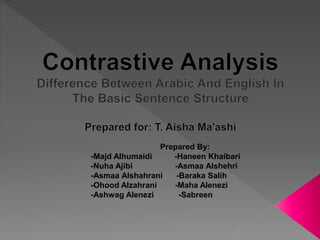
Difference Between English And Arabic Basic Sentence Structure
- 1. Prepared By: -Majd Alhumaidi -Haneen Khaibari -Nuha Ajibi -Asmaa Alshehri -Asmaa Alshahrani -Baraka Salih -Ohood Alzahrani -Maha Alenezi -Ashwag Alenezi -Sabreen
- 3. Introduction : English and Arabic belong to two different and distant language families: Western Germanic, and Semitic. Consequently, their grammars are sharply different. So there are major differences in the syntax of those two languages. This huge difference is caused by more than one factor like the order or the types of sentences for instance. In this analysis we intend to elaborate and clarify this topic further more.
- 4. English And Arabic Basic Sentence Structure: There are two major types of sentences, nominal and verbal. One of the main differences between Arabic and English grammar is that English has verbal sentences only, whereas Arabic has both nominal and verbal sentences.
- 5. A nominal sentence requires no verb of any kind. In general, it consists of two nouns , the first is called 'Topic/Subject' (المبدأ/إليه المسند) , and the second is called 'Comment/Predicate' (الخبر/المسند) . Although English sentences start with a noun, this noun is called 'subject' (الفاعل/إليه المسند) , followed by the main verb (الفعل) of the sentence and an object or a complement ( S + V + O/C ). The English sentence cannot be described as grammatically correct unless it contains a main verb (P.Ghazala,1995). On the other hand, unlike English, Arabic has different types of sentences.
- 6. English: To understand sentence structures in the English language, you must first have a general understanding of the types of words that are used to make sentences. Any English sentence consists of three basic components or parts. The basic structure of the English sentence is ( S + V + O/C ).
- 7. S= Subject: the person or the thing that does something. She likes cats. ( "She" is the subject, and it is a pronoun) V= Verb: a word that expresses an action, occurrence, or a state of being. ( "likes" is the verb ) O= Object: the person or the thing that receives the action of the verb. ( "cats" is the object )
- 8. Arabic: On the other hand Arabic has different types of sentences and therefore , different structures . there are four types of Arabic sentences and they are : Verbal Sentences (الفعلية الجملة) Nominal Sentences (االسمية الجملة) Functional Sentences (اإلعراب من محل لها التي الجمل) Non-Functional Sentences (محل لها ليس التي الجمل اإلعراب من)
- 9. Of course we are mainly concerned with the first two types which are the main ones. - The structure of the Arabic verbal sentence is ( V + S + O/C ) . So the order as you can obviously see is different but the components are mainly the same of the English. There are variations on verbal sentence types in Arabic like the 'kaana sentence' , the conditional sentence , the imperative sentence ..etc.
- 10. - The structure of the nominal sentence is (Topic + Comment), no verbs at all . Also there are variations on nominal sentence types in Arabic like the 'Inna sentence' , the prepositional sentence, the adverbial sentence, and the fronted comment and belated topic sentence.
- 11. The verb in verbal sentences usually precedes the subject but when it follows the subject, the sentence turns into a nominal one. The difference between a verbal and nominal sentence is that the former relates an act or event, whereas the latter gives a description of a person or thing.
- 12. -Examples : ArabicEnglish The same English sentence can be translated into Arabic in two different ways : As a Nominal sentence : كرة يلعب أحمدالقدم. It can be translated this way and be grammatically correct. ''أحمد here is a topic not a subject. As a Verbal sentence : القدم كرة أحمد يلعب We changed the order of the verb and the subject making the structure : V + S + O Ahmed plays soccer . Although this sentence starts with a noun, this noun this noun is the subject of the verb that comes after and that does not make the sentence Nominal. English as we said has only verbal sentences so this sentence is verbal. The structure : S + V + O And it’s the same in all grammatically correct English sentences.
- 13. One of the most common mistakes that students make, is to translate the sentences between the two languages in the same order. Although it's a simple rule that each of them has its own structure and order , but students still make this mistake more often.
- 14. Example : EnglishArabic Some students translate the previous Arabic sentence this way : Studies Hend History. This is a huge mistake because it is completely wrong to duplicate the Arabic sentence structure. We do not translate words only. We have to pay attention to the set of rules or grammar , the order , of each language. So the correct translation is : Hind studies History. S + V + O التاريخ هند تدرس V + S + O
- 15. Conclusion : To conclude, since English and Arabic are two different languages from different origins and families, they both have their own grammar, vocabulary, style, and phonology. In this paper, we discussed the basic grammatical structure of the sentence in the two languages in details and differentiated between them. So you have to be able to distinguish them and never mix their characteristics as two amazing, different, rich languages.
- 16. References : Gazalah .H , (1995). Translation As Problems And Solutions: A Text Book For University Students And Trainee Translators Pp. 46 .Jeddah,JED: Konooz AL-Marifa Company. Moubaiddin, A., Toffaha, A., Obeid, N., & Hammo, B. (2013, December 14). Investigating the Syntactic Structure of Arabic Sentences. Retrieved from http://ieeexplore.ieee.org/xpl/login.jsp?tp=&arnumb er=6487275&url=http://ieeexplore.ieee.org/xpls/abs _all.jsp?arnumber=6487275